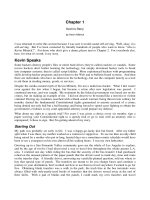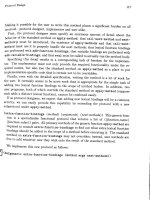The Art of Intrusion Detection doc
Bạn đang xem bản rút gọn của tài liệu. Xem và tải ngay bản đầy đủ của tài liệu tại đây (853.12 KB, 39 trang )
J. Wang. Computer Network Security Theory and Practice. Springer 2008
Chapter 9
The Art of Intrusion
Detection
J. Wang. Computer Network Security Theory and Practice. Springer 2008
Chapter 9 Outline
9.1 Basic Ideas of Intrusion Detection
9.2 Network-Based and Host-Based Detections
9.3 Signature Detections
9.4 Statistical Analysis
9.5 Behavioral Data Forensics
9.6 Honeypots
J. Wang. Computer Network Security Theory and Practice. Springer 2008
Basic Ideas of Intrusion
Detection
What is Intrusion?
E.g. Malice gets Alice’s user
name & password and
impersonates Alice
Intruders are attackers who
obtain login information of
legitimate users and
impersonate them
J. Wang. Computer Network Security Theory and Practice. Springer 2008
Basic Ideas of Intrusion
Detection
Observation! (Back to mid-1980’s)
Intruder’s behavior is likely to be substantially different from the
impersonated users
The behavior differences can be “measured” to allow quantitative
analysis
Intrusion detection:
Identify as quick as possible intrusion activities occurred or are
occurring inside an internal network
Trace intruders and collect evidence to indict the criminals
Common approach: Identify abnormal events
How about building an automated tool to detect these behaviors?
Intrusion Detection System (IDS)
J. Wang. Computer Network Security Theory and Practice. Springer 2008
Basic Methodology
Log system events and analyze them
Can be done manually if log file is small. But a log file could be big… need
sophisticated tools
Can be generated to keep track of network-based activities and host based activities
Network-based detection (NBD)
Host-based detection (HBD)
Both (hybrid detection)
J. Wang. Computer Network Security Theory and Practice. Springer 2008
Basic Methodology
Auditing
Analyzing logs is often referred to as auditing
Two kinds of audits
Security profiles: static configuration information
Dynamic events: dynamic user events
Parameters Values
Password Minimum length (bytes)
Lifetime (days)
Expiration warning (days)
8
90
14
Login
session
Maximum number of unsuccessful attempts allowed
Delay between delays (seconds)
Time an accounts is allowed to remain idle (hours)
3
20
12
subject action object exception
condition
resource
usage
time stamp
Alice
Alice
Alice
executes
opens
writes
cp
./myprog
etc/myprog
none
none
write fails
CPU:00001
byte-r: 0
byte-w: 0
Tue 11/06/07 20:18:33 EST
Tue 11/06/07 20:18:33 EST
Tue 11/06/07 20:18:34 EST
J. Wang. Computer Network Security Theory and Practice. Springer 2008
IDS Components
Three components:
Assessment
Evaluate security needs of a system and produce a security
profile for the target system
Detection
Collect system usage events and analyze them to detect
intrusion activities
User profile, acceptable variation
Alarm
Alarm the user or the system administrator
Classify alarms and specify how system should respond
J. Wang. Computer Network Security Theory and Practice. Springer 2008
IDS Architecture
Command console
Control and manage the target systems
Unreachable from external networks
Target service
Detect intrusions on devices
J. Wang. Computer Network Security Theory and Practice. Springer 2008
Intrusion Detection Policies
IDP are used to identify intrusion activities
Specify what data must be protected and how well they should be
protected
Specify what activities are intrusions and how to respond when they are
identified
False Positives vs. False Negatives
Behavior Classifications
Green-light behavior: a normal behavior acceptable
Red-light behavior: an abnormal behavior must be rejected
Yellow-light behavior: cannot determine with current information
Reactions to red-light and yellow-light behavior detections:
Collect more info for better determination, if yellow-light behavior
Terminate user login session, if red-light behavior
Disconnect network, if red-light behavior
Shut down computer
J. Wang. Computer Network Security Theory and Practice. Springer 2008
Unacceptable Behaviors
Behavior:
A sequence of events or a collection of several sequences of events
Acceptable behavior:
A sequence of events that follow the system security policy
Unacceptable behavior:
A sequence of events that violate the system security policy
Challenging issues:
How to define what behaviors are acceptable or unacceptable?
How to model and analyze behaviors using quantitative methods
J. Wang. Computer Network Security Theory and Practice. Springer 2008
Chapter 9 Outline
9.1 Basic Ideas of Intrusion Detection
9.2 Network-Based and Host-Based Detections
9.3 Signature Detections
9.4 Statistical Analysis
9.5 Behavioral Data Forensics
9.6 Honeypots
J. Wang. Computer Network Security Theory and Practice. Springer 2008
Network-Based Detections (NBD)
NBD analyzes network packets
NBD:
Identify yellow-light behaviors, red-light behaviors
Send warning messages to alarm manager in command console
Log packets in event log for future analysis
Two major components:
Network tap:
tap network at selected points to gather information
Detection engine:
Analyze packets and send warning messages
J. Wang. Computer Network Security Theory and Practice. Springer 2008
NBD Architecture
Network-Node Detections
Inside a target computer
Network-Sensor Detections
At a selected point of network
Need a network tap
J. Wang. Computer Network Security Theory and Practice. Springer 2008
NBD Pros and Cons
Advantages:
Low cost
No interference
Intrusion resistant
Disadvantages:
May not be able to analyze encrypted packets
Hard to handle large volume of traffics in time
Some intrusion activities are hard to identify
Hard to determine whether the intrusion has been
successfully carried out
J. Wang. Computer Network Security Theory and Practice. Springer 2008
Host-Based Detections (HBD)
HBD analyzes system events and user behaviors and alert the alarm
manager
Check an event log to identify suspicious behavior
Check system logs, keep record of system files
Check system configurations
Keep a copy of the event log in case an intruder modifies it
J. Wang. Computer Network Security Theory and Practice. Springer 2008
HBD Pros and Cons
Advantages:
Can detect data encrypted during transmissions
Detect intrusions that cannot be detected by NBD
Do not need special hardware devices
Check system logs, more accurate
Disadvantages:
Require extra system managing
Consume extra computing resources
May be affected if host computers or servers affected
Cannot be installed in routers or switches
J. Wang. Computer Network Security Theory and Practice. Springer 2008
Chapter 9 Outline
9.1 Basic Ideas of Intrusion Detection
9.2 Network-Based and Host-Based Detections
9.3 Signature Detections
9.4 Statistical Analysis
9.5 Behavioral Data Forensics
9.6 Honeypots
J. Wang. Computer Network Security Theory and Practice. Springer 2008
Signature Detection
Also referred to as
operational detections or
rule-based detections
Inspect current events and
decide whether they are
acceptable
Two types of signature
detections:
Network signatures
Analyze packet behaviors
Host-based signatures
Analyze event behaviors
A set of behavior rules:
System files should not be
copied by users
Users should not access
disks directly
Users should not probe other
users’ personal directories
Users should not keep on
trying to log on their accounts
if three attempts have failed
…
J. Wang. Computer Network Security Theory and Practice. Springer 2008
Signature Classification
J. Wang. Computer Network Security Theory and Practice. Springer 2008
Compound Signature Examples
Network-based activities Host-based activities Compound signatures
a user uses FTP to log on
to the system and uses cd
and ls commands
a user browses the etc
directory and read the
passwd file
a user browses system
files from a remote
computer
a user uses FTP to log on
to the system and uses
the put command
the files uploaded to the
system have virus and
Trojan horse signatures
a user uploads malicious
software to the system
from a remote computer
a user uses FTP to log on
to the system and uses
the put command
a user modifies system
files and registry entities
a user modifies system
files from a remote
computer
a certain Web attack read system executable
files
a Web attack is
successful
Examples of compound signatures
J. Wang. Computer Network Security Theory and Practice. Springer 2008
Outsider behaviors and insider
misuses
Insider: A person with authenticated access to a
system
Outsider: A person without authenticated access to a
system
Use outsider behaviors to detect intrusion:
Attacker may plant a Trojan horse, hijack a TCP
connection, or try a sweeping attack
Use insider misuses to detect intrusion:
Attacker may do things legitimate users would not normally
do
J. Wang. Computer Network Security Theory and Practice. Springer 2008
Signature Detection System
Build-in System
Store detection rules inside the system
Provide an IDS editor to user
User can select rules based on their needs
Programming System
Has default rules and a programming language
Allow users to select rules and define their own rules
Expert System
More specific and comprehensive
Require domain experts
J. Wang. Computer Network Security Theory and Practice. Springer 2008
Chapter 9 Outline
9.1 Basic Ideas of Intrusion Detection
9.2 Network-Based and Host-Based Detections
9.3 Signature Detections
9.4 Statistical Analysis
9.5 Behavioral Data Forensics
9.6 Honeypots
J. Wang. Computer Network Security Theory and Practice. Springer 2008
J. Wang. Computer Network Security Theory and Practice. Springer 2008
Common Approaches
Two common approaches to identifying unacceptable events
based on quantified event measures:
Threshold values of certain measures
Simple but inaccurate
Count No. of occurrences of certain events during a period of time
User profile
More accurate
Collect past events of a user to create user profiles based on certain
quantified measures









